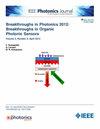Mean-Reverting Diffusion Model-Enhanced Scattering Imaging
IF 2.4
4区 工程技术
Q3 ENGINEERING, ELECTRICAL & ELECTRONIC
引用次数: 0
Abstract
Scattering media disrupt the rectilinear propagation of light, significantly degrading the resolution and clarity of optical imaging systems. Current scattering imaging techniques usually focus on simple targets and present limitations in imaging quality and reconstruction efficiency. To address these limitations, a mean-reverting diffusion model-enhanced scattering imaging (MRDS) is proposed. During training, prior information is extracted by diffusing the training data into an intermediate state with stable Gaussian noise. Reconstruction begins with low-quality images from physically-guided inversion, followed by iterative solving of reverse-time stochastic differential equations via the Euler-Maruyama method, integrating learned prior information to efficiently reconstruct high-quality images. Simulative and experimental validations demonstrate that MRDS outperforms traditional methods in reconstructing images with fewer artifacts and enhanced detail clarity. Quantitative metrics further demonstrates excellent reconstruction performance, with average metrics reaching 41.19 dB for PSNR, 0.99 for SSIM and 0.0085 for LPIPS. The reconstruction time per image is 2.19 seconds, representing a 44.2-fold acceleration compared to conventional methods. The proposed method achieves high-quality reconstructions of complex targets in a significantly shorter time, which dramatically boosts the efficiency of scattering imaging.均值恢复扩散模型增强散射成像
散射介质破坏光的直线传播,严重降低了光学成像系统的分辨率和清晰度。目前的散射成像技术主要针对简单的目标,在成像质量和重建效率方面存在局限性。为了解决这些限制,提出了一种均值恢复扩散模型增强散射成像(MRDS)。在训练过程中,通过将训练数据扩散到具有稳定高斯噪声的中间状态来提取先验信息。从物理引导反演的低质量图像开始重建,然后通过Euler-Maruyama方法迭代求解逆时随机微分方程,整合学习到的先验信息,有效地重建高质量图像。仿真和实验验证表明,MRDS在图像重建方面优于传统方法,具有更少的伪影和更高的细节清晰度。定量指标进一步显示了出色的重建性能,PSNR的平均指标达到41.19 dB, SSIM的平均指标为0.99,LPIPS的平均指标为0.0085。每幅图像的重建时间为2.19秒,比传统方法加快了44.2倍。该方法在较短的时间内实现了复杂目标的高质量重建,极大地提高了散射成像的效率。
本文章由计算机程序翻译,如有差异,请以英文原文为准。
求助全文
约1分钟内获得全文
求助全文
来源期刊

IEEE Photonics Journal
ENGINEERING, ELECTRICAL & ELECTRONIC-OPTICS
CiteScore
4.50
自引率
8.30%
发文量
489
审稿时长
1.4 months
期刊介绍:
Breakthroughs in the generation of light and in its control and utilization have given rise to the field of Photonics, a rapidly expanding area of science and technology with major technological and economic impact. Photonics integrates quantum electronics and optics to accelerate progress in the generation of novel photon sources and in their utilization in emerging applications at the micro and nano scales spanning from the far-infrared/THz to the x-ray region of the electromagnetic spectrum. IEEE Photonics Journal is an online-only journal dedicated to the rapid disclosure of top-quality peer-reviewed research at the forefront of all areas of photonics. Contributions addressing issues ranging from fundamental understanding to emerging technologies and applications are within the scope of the Journal. The Journal includes topics in: Photon sources from far infrared to X-rays, Photonics materials and engineered photonic structures, Integrated optics and optoelectronic, Ultrafast, attosecond, high field and short wavelength photonics, Biophotonics, including DNA photonics, Nanophotonics, Magnetophotonics, Fundamentals of light propagation and interaction; nonlinear effects, Optical data storage, Fiber optics and optical communications devices, systems, and technologies, Micro Opto Electro Mechanical Systems (MOEMS), Microwave photonics, Optical Sensors.
 求助内容:
求助内容: 应助结果提醒方式:
应助结果提醒方式:


